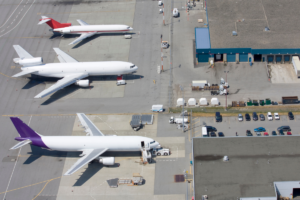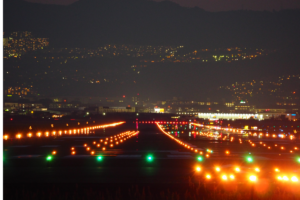Airports are pivotal in the modern globalized world, connecting people and goods across vast distances. However, this essential infrastructure often consumes massive amounts of energy, leaving a considerable carbon footprint.
In recent years, airports have invested in sustainable practices and technologies to mitigate their environmental impact. Airport lighting technology plays a crucial role in this ongoing sustainability journey while improving safety, lowering costs, and reducing light pollution.
Here are six examples of airport lighting technology that support airports sustainability objectives:
LED Lighting Technology In Airports
One of the primary ways airport lighting technology contributes to sustainability is through energy efficiency. Traditional lighting systems that use incandescent or halogen bulbs are highly inefficient and consume large amounts of electricity. However, modern lighting solutions like LEDs have revolutionized how airports light their interior and exterior spaces.
LEDs offer significant energy savings compared to conventional lighting. They are highly efficient, converting a higher percentage of electricity into visible light. This efficiency translates into reduced energy consumption and lower greenhouse gas emissions. Airport runways, taxiways, and terminal areas have all benefited from LED lighting, helping airports meet their sustainability goals by reducing their carbon footprint.
Furthermore, LEDs have a longer lifespan than traditional lighting sources, thereby reducing maintenance and replacement costs, further contributing to sustainability by conserving resources and reducing waste.
Precision Approach Path Indicators (PAPI)
PAPIs are a crucial part of airport lighting technology. They provide visual guidance to pilots during approach and landing, assisting them in maintaining the correct glide path and making more precise landings. This technology offers superior visibility in all weather conditions during approach. This can help pilots to maintain a constant glide path and angle during landing.
Airport Lighting Control And Monitoring Systems (ALCMS)
Airport lighting technology has evolved beyond simple on/off switches. Modern airports employ precision lighting control systems that dynamically adjust lighting intensity according to operational needs with the help of ATC. These systems utilize sensors, weather data, and real-time information to optimize lighting conditions.
For example, during periods of low visibility due to fog, precision control systems with the help of ATC can increase the intensity of runway lights, enhancing pilot guidance. This dynamic control reduces unnecessary light output during clear nights or when there is no flight activity, minimizing light pollution and energy waste. By avoiding unnecessary illumination, airports conserve energy and reduce their carbon footprint.
Read More: How To Maintain And Troubleshoot Airport Lighting Systems
Nighttime Lighting Curfews At Airports
Many airports have implemented nighttime lighting curfews, reducing the use of runway and taxiway lighting during hours of reduced air traffic. This practice conserves energy and minimizes disturbance to nearby communities and ecosystems.
Airports may also employ a “follow the green” approach, which helps to illuminate the lights and show the pilot which way to taxi.
Wildlife-Friendly Lighting
Airports are increasingly aware of the impact of their lighting on local wildlife, particularly birds. Bright airport lighting can disorient migratory birds and lead to bird strikes, which is a significant safety concern. Airports are adopting wildlife-friendly lighting solutions to address this, including the use of specific light wavelengths that are less disruptive to birds’ navigation.
Advanced lighting technologies, such as shielded and fully cut-off fixtures, help airports minimize light spillage beyond their boundaries. By directing light downward and reducing skyglow, these fixtures improve sustainability by conserving energy and contributing to preserving the natural environment as part of their sustainability objectives.
Innovative Manufacturing And Research
Sustainability in airport lighting extends beyond the choice of bulbs. The materials used in lighting fixtures, such as aluminum or composite, are often chosen for their durability and recyclability. Additionally, the design of lighting fixtures and systems is now tailored to minimize light spillage and glare, reducing light pollution that can disrupt local ecosystems and communities.
Bio-inspired lighting systems offer another promising avenue for increasing airport lighting sustainability. These systems mimic natural lighting patterns, reducing the disruptive impact on local ecosystems and human circadian rhythms. Research in this area aims to strike a balance between safety and sustainability, ensuring efficient airport operation while minimizing its environmental footprint.
As airports continue to prioritize sustainability, we expect lighting technology to remain a key driver in airports reaching their objectives while setting precedents for sustainable infrastructure development in the broader transportation sector. In the future, airports will continue to be beacons of connectivity while demonstrating that progress and sustainability can coexist harmoniously on the runway of progress.
Call Airport Lighting Company For The Latest In Airport Lighting Technology
The Airport Lighting Company team is standing by to answer your questions about how our products can help your airport meet its sustainability objectives and improve the safety and reliability of your operation. Call 315-682-6460 for fast, friendly service you can count on.





